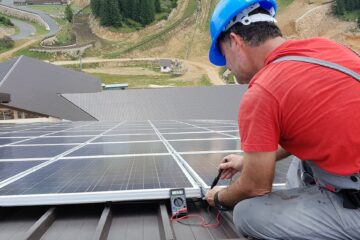Definition of Battery Energy Storage Systems
Battery energy storage systems (BESS) use batteries to store electricity from various sources, allowing the stored energy to be utilized later. These systems are frequently used with renewable energy sources, such as solar panels or wind turbines, to store excess energy generated during periods of low demand and release it during periods of high demand.
Importance of Battery Energy Storage Systems in Renewable Energy and Grid Stability
The significance of battery energy storage systems stems from their ability to aid in integrating renewable energy into the grid. Renewable energy sources are intermittent, so they do not always produce power. BESS enable excess renewable energy to be stored and used when the renewable source is not producing, smoothing out the electricity supply and making it more reliable.
Battery energy storage systems can help improve grid stability and reliability and their role in renewable energy integration. BESS can help reduce the need for fossil-fuel-based power plants to be brought online during times of high demand by storing excess energy, lowering greenhouse gas emissions, and improving overall grid efficiency. They can also provide backup power in the event of a power outage or other disruption.
Types of Battery Energy Storage Systems
Various battery energy storage systems are available, each with its own distinct characteristics and application suitability. Here’s a rundown of the multiple types of batteries used in energy storage systems.:
Lead-acid batteries: This is the most common type of battery used in energy storage systems and has been around for over 150 years. They are less expensive than other types of batteries but have a shorter lifespan and less energy-dense. Lead-acid batteries are commonly used in small-scale energy storage systems and backup power systems.
Lithium-ion batteries: Because of their high energy density, long lifespan, and low maintenance requirements, they are becoming increasingly popular in energy storage systems. They are more expensive than lead-acid batteries at first, but they can last longer and provide a higher return on investment over time. As a result, large-scale energy storage systems and electric vehicles frequently use lithium-ion batteries.
Nickel-cadmium batteries: Nickel-cadmium batteries are similar to lead-acid batteries in price, but they have a higher energy density and a longer lifespan. However, because of environmental concerns about cadmium disposal, they are less widely used than other types of batteries.
Nickel-metal hydride batteries: Nickel-metal hydride batteries are similar to nickel-cadmium batteries, but they lack cadmium and are thus more environmentally friendly. In addition, they have a higher energy density and a longer lifespan than lead-acid batteries, but they are more expensive.
Flow batteries: Flow batteries store energy in external tanks of liquid electrolytes rather than the battery itself. Increasing the size of the tanks allows for potentially infinite energy storage capacity. Flow batteries, which have a longer lifespan than other types of batteries, are frequently used in large-scale energy storage applications.

Applications of Battery Energy Storage Systems
In the energy sector, battery energy storage systems have a variety of applications, including:
Renewable energy integration: One of the primary applications of battery energy storage systems is integrating renewable energy sources such as solar panels and wind turbines into the grid. BESS allow excess energy generated by these sources to be stored and used when demand is high, smoothing out the supply and making it more reliable.
Microgrids: A microgrid is a local energy grid separate from the primary grid and can function independently. In microgrids, battery energy storage systems can store excess renewable energy and provide backup power during outages or other disruptions.
Peak shaving: BESS can “shave” off energy demand peaks by storing excess energy during low demand and releasing it during high demand. This can reduce the need to bring fossil-fuel-based power plants online during peak demand periods, improving overall grid efficiency and potentially lowering energy costs.
Backup power: Battery energy storage systems can also provide backup power during power outages or other grid disruptions. This is particularly useful for critical infrastructure and emergency services that require a consistent power supply.
Advantages of Battery Energy Storage Systems
There are several advantages to using battery energy storage systems:
Reduced reliance on fossil fuels: Battery energy storage systems can help reduce the need for fossil fuel-based power plants to be brought online by storing excess energy generated by renewable sources, lowering greenhouse gas emissions, and contributing to a cleaner energy mix.
Improved grid stability and reliability: BESS can help smooth out the electricity supply and make it more reliable by storing excess energy and releasing it when demand is high. This has the potential to improve overall grid stability and reliability.
Increased use of renewable energy sources: Battery energy storage systems can help increase the amount of renewable energy used in the grid by allowing excess renewable energy to be stored and used when the renewable source is not producing.
Potential cost savings: BESS can help lower energy costs by reducing the need for fossil-fuel-based power plants to be brought online during times of high demand. Furthermore, using renewable energy sources may result in long-term cost savings due to the decreasing cost of renewable energy technologies and the increasing cost of fossil fuels.

Challenges of Battery Energy Storage Systems
There are also several challenges to consider when it comes to battery energy storage systems:
High upfront cost: One of the most significant challenges of BESS is their high initial investment. While the price of battery technology has decreased in recent years, installing a battery energy storage system is often more expensive than other types of energy infrastructure.
Limited lifespan: Most batteries have a limited lifespan and must be replaced after a certain number of years or charging and discharging cycles. This can raise the cost of BESS maintenance and replacement.
Environmental concerns: Regarding battery energy storage systems, there are also environmental concerns, particularly regarding battery disposal. To minimize potential ecological impacts, batteries must be properly disposed of. Furthermore, the production of batteries can have environmental consequences, such as air and water pollution.
In conclusion, battery energy storage systems (BESS) are a promising technology that can help improve the energy grid’s reliability and sustainability. BESS can help integrate renewable energy into the grid and improve overall stability and reliability by storing excess energy generated by renewable sources and releasing it when demand is high. They can also provide backup power in the event of a power outage or other disruption.
While there are some drawbacks to using BESS, such as their high upfront cost and short lifespan, the benefits of this technology make it worthwhile to consider for various applications. BESS are likely to become an increasingly important part of the energy mix as battery technology costs continue to fall and the environmental impacts of production and disposal are addressed.


